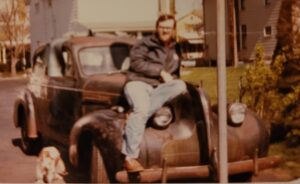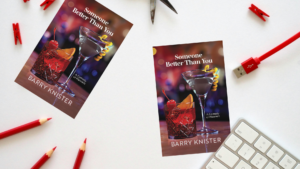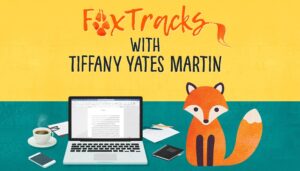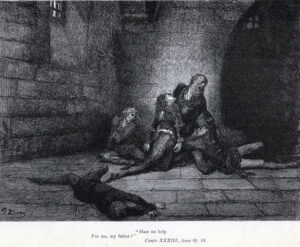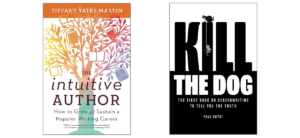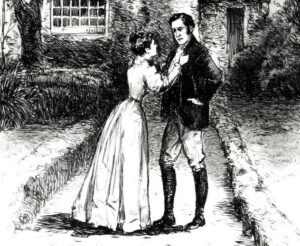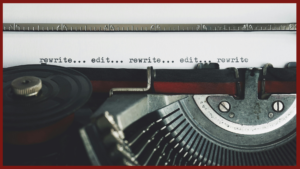Editing
The violent metaphor of writers killing their darlings has never appealed to me. I understand that we sometimes need to disrupt the comfort of our revision process, but may I suggest something a little less murderous? Tasty, even?
One of the treasured picture books of my childhood was Stone Soup. Have you read it? In this retelling of an old European fable, a hungry traveler approaches a village known for its miserly inhabitants. Desperate for food, he concocts a trick to get them to feed him. He sets up a large cauldron in the middle of the town square and fills it with water, then places a stone in the bottom of the cauldron. As it heats up, a villager comes to ask him what he’s doing.
“I’m making stone soup,” he replies, stirring the water and occasionally taking a sip. “It’s coming along nicely, but it would taste better with salt.”
The curious villager runs home and brings back some salt. By now, a crowd has gathered. The traveler seasons his soup with salt, takes another sip, and sighs. “An onion or two would be just the thing,” he says. A second villager brings an onion.
On and on it goes, with the additions of carrots, potatoes, and whatever else would go into a hearty stew. At the end, he fishes out his stone and shares a delicious meal with the no-longer hostile and selfish village. Together they’ve created stone soup.
This story delighted me on multiple levels. I loved the ingenuity of the newcomer, the gradual and piecemeal thawing of the villagers, the delicious soup that fed them all. I loved the chutzpah of fooling an entire town into thinking that a stone chucked into some boiling water could become something worth consuming.
As an adult, I still delight in the story of stone soup, but now I read it as a good metaphor for writing (isn’t everything?).
Your brain picks up a shiny bauble of an idea. It might be an interesting character, a fabulous setting, or a devilishly twisty plot. If a story in its most simplified form is simply a person, in a place, with a problem, then any of those three elements could be the stone tossed into the cauldron of your imagination.
The water comes to a boil as you go about your daily life. Soon, if your mind is at all like mine, your subconscious starts to sniff around. What’s cooking? Is it any good?
The nay-saying villagers who have colonized my mind, at least, can be a pretty suspicious bunch. They tell me that a rich and hearty story will never result from that bare rock sitting at the bottom of my pot—but they can be tricked into sharing the observations that are hidden inside the cupboards of my memory.
With a little persuasion, they open the cabinets and rummage around. Ideas, snatches of conversation, resonances from other books, and intriguing people I’ve met all add ingredients to the mix:
That guy with a scar that I saw at the bus stop? He’d make a perfect salty foil.
That snatch of conversation I overheard in the coffee shop? Unexpected zest.
That book I just finished reading, the one that tells its story in layers like an onion? I might slice it […]
Read MoreConsider this snippet of dialogue:
“What’s her name?”
“Janet.”
“I don’t feel comfortable calling anyone by their first name, especially a woman. Do you know her last name?”
“No, I don’t. You’ll just have to call her Janet, I guess.
Perfectly good, serviceable stuff, right? Clear, fairly concise, smooth. Now look at how Rex Stout actually did it in the short story “The Cop Killer:”
“What’s her name?”
“Janet.”
“I call few men, and no women, by their first names. What’s her name?”
“That’s all I know, Janet. It won’t bite you.”
The same information, but you can hear Nero and Archie in the second version. That difference is voice.
I’ve written before about how elusive voice can be. I’ve suggested possible places to look for it and covered some of the hallmarks of good dialogue. Today, let’s take a deeper dive into how it can be done.
In the example above, notice how the word choice – and the unspoken assumptions behind the word choice — fit the two characters. Nero’s love of precise language is there in the concision and precision of the parallel “few men and no women.” The exact repetition of the question, “What’s her name,” amounts to an imperious rejection of Archie’s use of the first name. And Archie’s self-possession is there in his breezy dismissal of Wolf’s rejection. Essentially, their characters and their relationship are all there in those two lines of dialogue.
Or, take another example.
Every Christmas for the last few years, I have been sharing car-related passages from some of my favorite authors on a site for old car geeks. This year’s passage, from John Jerome’s 1979 book Truck, is also one of the best examples of distinctive character voice I’ve seen. The background: in 1970, Jerome bought, for various philosophical reasons, a 1950 Dodge pickup and spent a year getting it running again. Through a combination of ignorance and mild stupidity, he destroyed a relatively obscure part – the timing chain cover — and wrote to various junkyards trying to track down a replacement. This introduced him – and us – to Armad T. Winship, a junkyard owner in Fontana, California.
You can read the entire passage here, but here are some highlights of Mr. Winship’s letter. Spelling and punctuation are as in the original.
You might not believe it but space is and always has been the problem even before Fontana got the “middle-age spread” and passed ordinances in restraint of our trade. Ten acres is all we have left, guess how may cars that will hold and Ill send you free a dimmer switch for your truck, no rust, out of the packing box, if you come with 20 of the correct number. We have a special technique for getting the most cars on the smallest lot, no its not on their sides.
*******
I . . . drove crosscountry in a 36 Plymouth in 1940 just before the War, a sweet running little car if you didn’t try to push it in the desert. Everyone had those canvas waterbags on their bumpers so the evaporation would keep it cool. We didn’t and like to died, it felt like. I asked a man in a filling station for a little […]
Read MoreToday’s “ad post” is also a valuable blog post written by our own Barry Knister, detailing his experience with two editors while preparing his novel, Someone Better Than You, for publication. Enjoy!
Deciding to work with an editor is a major decision. It costs money, and calls on the writer to do something analogous to what all good parents must do: love their children enough to let them go (at least until they come home and move into the basement).
That’s what the writer does when she turns over her baby to an editor. This person will get to know the fledging novel or memoir, but usually with no knowledge of how it came to be. That means, when the baby comes home, the writer must will herself into a kind of amnesia, in order to absorb and respond to the stranger’s reactions.
That’s why I urge writers to read a report, but to then put it aside for a week or more before going back to it. Otherwise, they risk acting or reacting on impulse.
Recently, I worked with two editors on my forthcoming novel, Someone Better Than You. By coincidence, both people are past editors for Penguin. In every respect, working with these editors led to improvements in my novel. I acted on most but not all of their suggestions, and what follows is my attempt to summarize the process.
RONIT WAGMAN
I first hired Ronit in 2020 to read and report on the full manuscript of what was then titled Ashley and the Jell-O Hour. Although she liked the story (“the world of the novel and the characters that dwelled in it felt deeply authentic to me”), she had several major criticisms.
AGENCY
In the version Ronit read, my main character Brady “Buzz” Ritz is a retired newspaper editor. His life is upended when he publishes a book of his anonymously published satirical columns. He blunders mightily by publishing the book’s second edition under his own name.
In this first version, Brady’s book comes about through the actions of others. The editor of Grumble (the little magazine that first published his column) talks Brady into developing a book of his work. Ritz’s best friend from his newspaper days gets an agent friend to find a publisher. Most importantly, the best friend shames Ritz into using his own name for the second edition.
As Ronit explained, I had made my main character the passive pawn of others. Someone else pushes him to develop the book, and someone else arranges for it to be published. Most importantly, someone else is responsible for Ritz publishing the second edition under his own name.
Ronit’s guidance led me to make Ritz less a passive actor, and more the responsible agent for his story. He still gets the idea for the book from his editor, but as Ronit pointed out, no agent would take on such a manuscript from an “anonymous” writer—because no publisher would be interested in such a book.
So, I replaced a commercial publisher with a university press whose editor has the freedom to publish something by an unknown writer. I also got rid of the idea of a second edition. Once I made these changes, I was free to make Brady responsible for the […]
Read MoreDesign by Camille LeMoine
This is the eighth installment of these nerdy linguistic posts, an accidental series I stumbled into on seeing how many of the Writer Unboxed community share my appreciation for the delights and idiosyncrasies of words.
Generally I like to approach these posts from a fairly light and irreverent perspective, but today, to borrow from Hamilton, can I be real a second? For just a millisecond? Let down my guard and tell the people how I feel a second?
For all our gleeful enjoyment of the many vagaries of words, they are among the most powerful forces of society and history, which makes authors the formidable warriors who craft and wield them. As the cliché goes, the pen is infinitely mightier than the sword.
And like any warrior, we can choose to use our sword to destroy or to build.
Heroes Rise in Darkness
How many stories have you read where the hero triumphantly rides into a world where all is good and right and bending toward justice? That wouldn’t be much of a tale to tell; what makes a hero heroic is how he handles a world gone wrong.
Maybe it’s hubris or self-importance or just my own in-built bias toward creativity and the power of language, but I think authors and artists are often the heroes of history. Storytellers shed light in the darkness, increase connection and understanding, open minds and hearts. Yes, it may be politics and people who shape the course of the world, but it’s the storytellers who can help shape the ideas and mindsets behind them.
But it requires heroes, those who can transcend the oh-so-human reactions of fear and hopelessness and rage and contempt and disgust to spin a golden thread to connect one person to another, and to teach them to spin their own golden threads to draw in others. Weaving together all those tiny threads can create an unbreakable rope that can help guide all of us toward the good.
No one was ever attacked into changing their mind. Few people reexamine their views and search their heart because they were shamed or mocked or belittled or dismissed. On the contrary, those approaches are almost guaranteed to make most people entrench, to double down on their worldview, and to feed the flames of their own fear or hate or rage.
In moments like that we look to the heroes to help save us, to help create a future with promise and hope and love and good. And the heroes are those who can transcend their own darker feelings to help spread light into the world.
We are the heroes we’ve been waiting for, we wordsmiths. We have to be. The ones who understand the power and potential of that mighty tool we wield to divide or to unite.
Words Can Wound—or Heal
In 2018, outspoken comedian Sarah Silverman tweeted that she was trying to understand people who voted for Donald Trump, and was subsequently attacked on Twitter by a man trying to cut her down with his words, including a potent one intended to diminish and vilify women that many people have a visceral reaction to (it refers to female genitalia and rhymes with punt).
The understandable impulse is to strike back, particularly for those of […]
Read MoreNaming characters is my least favorite part of writing. A character’s name imparts more than just a moniker by which to differentiate actors in a plot. Names are powerful—they provide limits and possibilities to what the character might be or do. For me, the wrong name for a character throws things off in the writing. A character that has not been given the right name misbehaves. Beatrice would not speak the same way that Susan would. Ernest would choose different clothes from Roderick. Until I find the right name for a character, they don’t willingly occupy their role within the larger story.
While clearly I tend to overthink things, these expectations are extensively influenced by stereotypes and preconceptions. The connections we make when we hear someone’s name are as instantaneous, as deep-rooted, and as difficult to shift as first impressions. Getting them right is worth a little extra time and consideration.
I’m not going to tell you how to choose or derive a name—there are numbers of name generator tools on-line. I’m going to try to highlight the complexity and variety of ways in which a name can influence first impressions to help provide you with ways to assess what name best fits your character and your story.
The Power of Names:
Names create expectations, not just of the person’s individual characteristics, but also of their background:
Read More
I’m a sucker for happy endings.
I’ve written before, though, that a lot of writers tend to shy away from them because they can easily degenerate into cliches. When the guys in the white hats always win and the guys in the black hats routinely go down in flames, endings start to get shallow and predictable. To avoid this, we get stories in which either nothing happens – stories that are more about creating character than watching character develop toward a climax – or where what happens to the characters is just the result of random, generally cruel fate.
I don’t buy that your only choice is between shallow, black-and-white morality and a descent into ennui and meaninglessness. Instead, I think we need to take a deeper look at where happy endings come from and what they mean. And a good place to start is the Middle Ages.
Happy endings, at their heart, are about justice. Good characters end well and evil ones end badly. But the medieval sense of justice runs deeper than the modern business of obeying the rules and making sure people who don’t obey the rules suffer. For them justice was based on the idea that any system – a person, a family, a community, a society, a nation – has a built-in structure to it, a way that it’s supposed to work. When you make choices that support that structure – letting go of a grudge to make way for forgiveness, supporting laws that protect vulnerable people from exploitation — you’re being just. When you work to break those structures down, you’re not. So according to medieval justice, stopping to let someone make a left turn to untie a knot in traffic is a just act. Picking up a shopping cart from the middle of the parking lot and returning it to the trolley is a just act. You’ve made a system, however small, work more the way it was intended.
The choices you make to support or break systems have consequences. Good people generally tend to do well because they are part of a healthier system. When evil people end badly, it’s not because some punishment’s been imposed from outside. Systems that break down tend to hurt the people that break them. To use a mechanical analogy (because, yes, I am a car geek), when you never change the oil in your engine, the engine isn’t punishing you by throwing a rod. There’s just a natural connection between clean oil and engine health.
You can see this connection between choices and consequences in Dante’s Inferno – or if you don’t have the patience for medieval Italian poetry, check out Larry Niven and Jerry Pournelle’s updated adaptation. The Inferno is renowned for the often gruesome punishments meted out to various types of sinners. But those punishments are always the direct (if graphic) result of the choices those sinners made in life.
In the circle of the betrayers, for instance, we meet Ugolino della Gherardesca and Archbishop Ruggieri degli Ubaldini. The real life Ugolio had been the leader of Pisa but betrayed the city to its enemies more than once. In one of the betrayals, Archbishop Ruggieri’s nephew was killed. So when the Archbishop captured Ugolino, he locked […]
Read MoreAs a connoisseur of writing how-tos (and yes, I had to look up how to spell connoisseur – and okay, “addict” might be a more accurate word), I have read a TON of them. And while I find valuable nuggets in nearly all of these books, lately I’ve noticed that many recent writing how-tos are essentially sharing slightly different flavors of some very similar core information.
So when I encounter a book about writing that offers some new (to me, at least) ways of looking at the craft, I sit up and take notice. My gushing ode to Chuck Palahniuk’s Consider This in this 2020 post is an example.
I just finished reading another such departure from mainstream writing how-tos: The Intuitive Author, by WU’s own Tiffany Yates Martin, who, in addition to being a wonderful writer and editor, is also an insanely good teacher and public speaker. Seriously, if you ever have the opportunity to attend one of Tiffany’s sessions or events, take it. And if you’re an author who speaks at literary conferences, trust me: you do NOT want to follow Tiffany. She’s that good.
Having seen Tiffany’s amazing presentation on backstory at WU’s brilliant 2022 OnCon, I knew what an extraordinary editorial mind she has, and how good she is at getting under the hood to amp up and improve your writing at multiple levels. So with The Intuitive Author, I guess I was expecting a book full of deep analysis into the mechanics of writing, along with some sophisticated editorial techniques. Instead, much of the analysis she offers in the book leans more towards the psychology and strategy involved in pursuing – and ideally, enjoying – the life of a writer.
I quickly realized I was not reading The Average Writing How-To, and I dove into the book with my curiosity piqued. (And yes, I had to double-check whether it was “piqued” or “peaked.” Got it right the first time – yay! Hey, it’s the small victories. But I digress…)
In short, The Intuitive Author is filled with insights and perspectives quite unlike those offered in the vast majority of writing how-tos currently on the market. And reading Tiffany’s book made me think about another writing how-to I’d recently read that takes a pretty big departure from most conventional writing wisdom: the provocatively titled Kill the Dog: The First Book on Screenwriting to Tell You the Truth, by author and screenwriter Paul Guyot.
What does this Guyot dude have against dogs, anyway?
Nothing, actually. Instead, the animal Guyot truly hates – and is taking a not-at-all thinly veiled swipe at – is the cat. Specifically, the cat in the well-known “Save the Cat!” series created by the late Blake Snyder.
If you’re not familiar, Snyder’s initial Save the Cat! book (STC to the cool kids) burst onto the scene in 2005 with a VERY structured set of templates for storytelling, which he reverse-engineered from studying many successful movie scripts. Targeted at aspiring screenwriters, Snyder’s methodology offered a compelling framework for them to adopt […]
Read MoreMary insists that Frank obey his family’s wishes and not see her anymore.
As writers, you always want to be pushing the boundaries of your reading. With that in mind, I’ve turned this month’s article over to my business partner, personal editor, fellow writer, and wife. Ruth can’t go very long without going back to her very favorite genre, nineteenth-century British novels, and her expertise far exceeds mine. Enjoy. Dave King
When I’m altogether tired of modern novels with their political correctness, literary preciousness, and occasional whiffs of meaninglessness — when I am, in short, weary of the modern world — I go back to my best reading joy: British novels of the mid-nineteenth century.
It was such a prodigious age for stories that the variety of novels written is enough to suit every reader-writer. One of my favorites is Thackery, where we meet the deplorable Becky Sharp, who lands herself in Brussels just in time for the battle of Waterloo. Thackery’s description of that world-changing carnage is the best account of the battle that I have ever seen in any source in literature or history. For those who would like to discover what kind of depressed and diminished history we women have triumphantly overcome, there are many nineteenth century sources. Think of the helplessness of a woman in a terrible marriage in The Mill on the Floss, or the misery of the sweet, young governess, Jane Eyre, betrayed by her arrogant and lordly employer.
But when I settle into a novel by my favorite author, Anthony Trollope, I am at home in a world where the characters are as modern and familiar as those around me in my own life. And his female characters are always as real as I am myself.
Lately, I’ve been revisiting The Chronicles of Barsetshire, his most famous work (with possible competition from The Pallisers). One of my favorites is the third in the series, Dr. Thorne, the account of a country doctor with no pretentions as to his profession. He is looked down on by those who cater only to the health of the upper class because he charges the same modest fee to everyone, rich or poor. He takes responsibility for his brother’s great sin in sexually forcing a dependent servant girl. After the death of the rapist, the servant falls in love with a man of her class who wants to emigrate to America but does not want to raise another man’s child. Dr. Thorne takes responsibility for the infant Mary, has her looked after by friends at a distance through infancy, gives her a fine education, and brings her as a young adult to Barsetshire, introducing her to the world as his niece.
Of course, she and Frank, the heir to the nearest stately home fall madly in love, though she is a penniless, illegitimate child, and Frank must marry money because his father has encumbered the vast acreage of his property with countless debts. The novel follows the story of how these two unlikely lovers find their happy ending against fearsome odds.
In the not-yet-formed structure of nineteenth-century novels, the author can do whatever he or she pleases and often does. So don’t be put off by, say, the […]
Read MoreMy dad, Grant Overstake, has written millions of sentences. As a former journalist, pastor, and now novelist, he’s got what the writing world considers “chops.” Big papers like the Miami Herald published his sports column for years, and small papers had his by-line on every article from op-eds to sports to obits.
His young adult sports novels are precise, beautiful, engaging. His sermons, spoken word he wrote to help rural Kansans navigate their faith journeys and complicated lives in the late 90s, were captivating, heart-felt, well-rounded. This man has done it all in the writing world — if I listed his awards, I’d reach my word-limit in this article.
I decided early in my life that I, too, would be a writer. If you’re a parent and you try to get your kid to find passion in the things you love, you likely will feel one of two things: the sting of rejection accompanying an eye-roll, or the wave of pride accompanying an attempt. My first attempt was verbal storytelling, just like my dad behind the pulpit. It turned into written storytelling as soon as I could hold a pen. Sign me up, Dad! I wanted to be like him.
Sometimes, a sign-me-up attitude can be intimidating as a parent. What if your child is no good? What if they’re not coachable? What if criticism of them is too much? I don’t know what form of bravery swept me as a child, but I showed my award-winning journalist father my first attempt at a novel, written in a wide-ruled spiral-bound notebook.
“Don’t overwrite,” he said. “Simplify it. Here, read this.” And he handed me Hemingway, Herman Hesse, and Rick Reilly.
In high school, he read my articles for the school paper and with his bracing, left-handed scrawl, edited with no hesitation. I remember, at first, that it stung. I might’ve cried. I was fifteen, learning from a master. I worked harder, read more closely, listened carefully. I built my words on the true stories from a small-town high school where football reigned supreme. In this world, the girls on the sidelines weren’t writing articles; they were dressed in cheer uniforms, caught up in the spectacle rather than the storytelling.
I donned a cheer uniform, too, and learned and listened to how sports were played. I wrote for myself, for my classes, for my newspaper, for essay contests. I sought my dad’s praise, his admiration, his subtle nod that affirmed I’d done it right. I won some of my own awards.
I had to learn, from an amazing writer, how to accept what a first draft is: each sentence might change. Bones are there, meat needs to fill in around it. Simpler is better. Red ink is strengthening your work. None of this is personal – these words are not tattooed on you. Nothing is permanent until the paper’s put to bed, kid. I remember the smell of newsprint, the dusting of ink on the sides of his hands, his press badge on the kitchen counter, his fingers calloused with the grip of a pencil.
I learned how to accept his red ink […]
Read MoreI’ve just learned a new word that speaks to the very soul of this semiregular column of mine: “grammando,” first used in 2012 by author and editor Lizzie Skurnick in her “That Should Be a Word” column in the New York Times Magazine.
As you might correctly infer, it refers to those people (I want to say “those of us” to myself and regular readers of this column) who take so seriously the strictly correct use of language that it may become their mission.
This word really hit a chord with me, as a former copy editor and current pedantic grammarian, and yet as I listened to linguist Anne Curzán on Adam Grant’s wonderful Re: Thinking podcast, where I first heard the term, I began rethinking my characterization of myself as a (rigid) word nerd.
I’m actually fascinated with slang and the evolution of language in the vernacular. To me—and I’m guessing to a lot of us—there’s music to the language we use, carefully thought out shades of meaning, sound and feel, and vibe we’re aiming for. In other words, voice.
One of the earliest lessons I learned as a copy editor was to respect the authors’ choices (or as I like to think of it, the editor’s Hippocratic Oath: “First do no harm”). Even if something’s technically wrong, if the author feels strongly about it they were generally permitted and even encouraged to overrule the correction.
I think one of the reasons I stayed in demand during my copyediting tenure was that not only was I able to pick up on author voice and such “off-label” usages, but also not try to homogenize it into rigid grammatical correctness.
Language purists, as in fact I have counted myself in the past, may be bristling right about now. I hear my mom’s voice in my head, for instance, bemoaning the end of civilization and humanity thanks to bastardizing our mother tongue.
But our mother tongue is not and never has been a fixed set of rules carved in ivory. With every subsequent generation it evolves with new usages and new words, and the extinction of others. In fact, Curzán cites the editors of the American Heritage Dictionary, whose board of adjudicators she serves on, who say that the basis of their job is to try to keep up how you cats are using the language.
Oh, wait, people aren’t actually cats. Sorry, dude. Oh, wait, not all of you are actual dudes, even those of you who identify as male, since a dude was originally a ranch hand in the West. My bad, unc…but wait, you aren’t my uncle….
I could have used the strictly correct “people” in the above sentence, but that felt a little vanilla for the playful tone and voice I want to strike in these posts. (Oh, wait, vanilla is a plant, and a flavoring derived thereof.)
My feeling is that the literal and rigidly correct use of language can be just flat boring. If there is one element of story that I frequently count to writers as the most important in grabbing your reader and setting your story apart in a world where there is […]
Read MoreTherese here to introduce you to someone near and dear to me: my son, Liam. ❤️
Liam’s screenwriting journey started as a Rod Serling fan. Inspired by Serling’s allegorical storytelling, he attended USC’s film school where his thesis film, You Missed a Spot, was selected in over 30 festivals internationally. Since then, he has worked on the production-side of the industry, most recently wrapping as the line producer’s assistant on FX’s Mayans MC.
You may have heard about the downturn of work in Hollywood, and so Liam has bided his time between jobs doing something he was likely, inevitably, genetically born to do: WRITE. That the short story he’s written, that he’s now determined to see produced (see Kickstarter), taps into a real-life wound should come as no surprise to you, WU community.
But I’ll let Liam tell you about that, WU-style. Take it away, kiddo.
As writers, we often face the challenge of crafting stories that feel authentic, especially when venturing into experiences we haven’t lived ourselves. This was the case for me when I set out to write my new short film, Venus in Furs, a psychological thriller that personifies heroin as a woman.
I’m a filmmaker living in Los Angeles, and my life was deeply impacted when one of my close friends from film school overdosed on drugs laced with the powerful synthetic opioid, fentanyl. I remember the first time I met him—we were attending a mandatory lecture on the cinema and music of the 1960s. We were sitting on either side of another student we both had a crush on and got into a pointless debate about The Doors, as if this poor girl remotely cared about some band from five decades ago. He demolished me in the debate. The guy was like Jim Morrison himself—long-haired, charismatic as hell, with a ribcage you could practically see through his t-shirt.
After the girl successfully escaped, the two of us grabbed lunch and admitted we were only trying to impress her. Instant friendship.
During lunch, our conversation abruptly ended when he mentioned he was going to leave to smoke some opium. I assumed he was joking at the time—I mean, I had just met the guy. What, opium? You mean that shit from the 1800s? But over time, I came to learn that he was affected by a powerful addiction that, to him, wasn’t some unshakable affliction as often depicted, but rather the means to radically take hold of his post-high-school freedom and live out the fantasy of the rock ’n’ roll lifestyle he so loved.
The last time I saw him, I visited his three-bedroom high-rise in Downtown Los Angeles, full of vintage records and a collection of Les Pauls paid for with credit cards he couldn’t pay off. It was the Fourth of July, and he was excited to launch fireworks at passing cars. At that point, I had witnessed the drug obliterate his ambitions. He had stopped attending classes, gained weight, and lost that magic spark that drew me to him in the first place. Heroin took everything from him. And yet he was so happy to participate in his own self destruction. In fact, sitting there with all his guitars and […]
Read MoreA couple months ago I stumbled across a draft of a novel manuscript I’d written many years ago. It was a story that had come to me all at once, and that (unlike all my other works in progress) had been a joy to write because it had flowed and it had taken my mind off some hard realities during a difficult time of life. I had finished the draft and then put it away.
In the spring of this year I was in another hard reality period of life and I don’t know if it was chance or fate that I came across that long-neglected draft but I sat down to read it. I still loved the story, and I could see clear as day how to refine it and make it stronger. I could also see how much of the first draft was just not needed. It was crowded with things I wrote while trying to get the draft down, but which didn’t contribute to the plot or which weren’t critical to the characters’ story arcs. They were all going to hit the cutting room floor.
Wouldn’t it be nice, I thought, if I could write a draft without all that dross and not spend all the extra time putting it in only to take it back out? The years that had passed since writing it gave me a gift—enough distance from the original writing of the story to make evident some lazy writing habits of mine that had contributed to the unnecessary passages.
I imagine every writer has their own writerly tics–the things they write when they are really searching for the next salient plot point, trying to nail down a setting, or figure out the character. Here’s my short list of my own top five lazy writing habits—the categories of things that didn’t need to get written and which certainly didn’t need to remain in the next draft. My hope is this list will give other readers a way to see their own literary surplusage.
Too much non-resonating detail.
That early draft had an incredible amount of detail that was just not needed and which actually distracted from the flow. When the characters went out for a meal, I described every dish in sequence. The waiter introduced himself and got a full description even though he was not relevant to the conversation or the plot. I devoted a full sentence to the boot tray that sat at the entrance to a house, described each individual piece of furniture within a room, and named every piece of equipment in a woodshop. In the best light, these details were setting a scene, but they were not part of the story.
Anyone who has eaten out understands that there are wait staff. Unless that person plays a role in the story they don’t need to be named or described. Anyone who has lived in sloppy climates knows what boot racks are for. Unless that boot rack was a murder weapon or would change a character’s life, it did not need a whole sentence.
Detail can be critical to a clearly told and understood story, but the details must matter, and they must create a story flow. Details that provide a relevant piece of information are […]
Read MoreIn Kathryn Craft’s WU post for May 9 (“To Diagnose or to Characterize?”), David Corbett makes the following comment:
“Having been in reading/writing groups early in my career, and having counseled students who’ve received curious feedback from other group members, I’ve come to realize that you have to be able to discern valid criticism from that which is something other than valid.”
These words registered with me. In part because of problems I met up with in a writers’ group, I have become a strong advocate for writers submitting their work to professional editors. It costs money, but in my view it’s money well spent. This assumes the writer takes pains to learn all she can before choosing an editor. But an editor and writer form a two-member writers’ group, so knowing how to “discern valid criticism” is no less important.
The practice for some who write WU posts is to wait to the end to summarize main points. But what comes first has the best chance of sticking with the reader, so up front, here are the TAKEAWAYS from today’s post on how to choose an editor.
1. Check the editor’s own writing. Whether it’s a marketing pitch or a response to your questions, make sure your would-be editor’s grammar, syntax and punctuation are as close to perfect as possible.
2. Ask for a sample edit. Editors usually offer to do a sample edit of a few pages to show possible clients how they work. (I would reject any editor who didn’t offer such a test sample.) Are the editor’s comments of the sample clear and useful?
3. Tap the spine. How-to books have become their own genre, and some editors write them. Two such excellent books that I’ve read were written by Writer Unboxed regulars Dave King and Tiffany Yates Martin. In both instances, the writing in their own books made the case for why I should do business with them. After all, editors are trying to sell themselves. They want you to hire them to edit your words. If their own words don’t measure up, I would forget whatever recommendation someone may have given to you, and move on.
4. Pay special attention to the choice of words editors use. Do they rely on commonplace buzzwords and cliches? Is there anything fresh or novel in what they themselves have written? For me, doing this is like using the “Look Inside” feature at Amazon. When I see a book description that sounds interesting, I read the opening pages. If they lack freshness or an intriguing voice, I don’t care what the writer’s reputation may be, whether the book has a zillion five-star reviews or made the NYT bestseller list. Same with editors. The writing has to sell me, not a list, or a third-party opinion.
5. Be sure you’re clear on the differences between copy editing, line editing, and developmental editing. You need to know them to fully understand the contract before you sign it.
6. Understand the beginning, middle and end—of your agreement. Will your arrangement with the editor also include follow-up contact after your manuscript has been edited? If so, will that involve additional charges? My arrangement with […]
Read More

